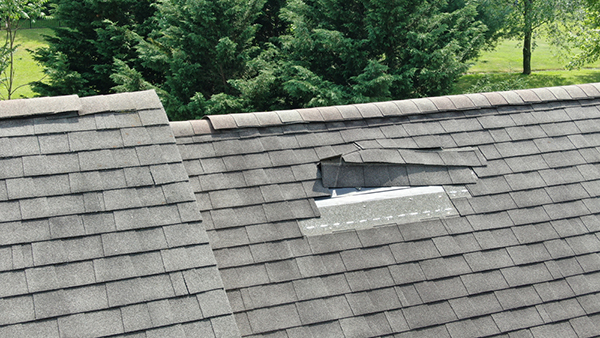Look for Signs of Roof Damage After a Storm
June 6, 2023
Checking for signs of roof damage should be every homeowner's first priority after a thunderstorm, hailstorm, tornado or low-category hurricane. Asphalt shingles are especially susceptible to serious storm damage, and may need replacement or repair.

For houses with asphalt roofs, the list of potential damage areas include loose shingles, dents and scrapes from severe winds, falling tree limbs and broken gutters.Learn how to spot damage and repair your roof before problems arise.
Signs of Roof Damage to Watch for
The damage an asphalt roof sustains often depends on the type of bad weather that takes place. In the aftermath of a tornado, for example, split roof seams and missing shingles can let in water that causes mold or wood rot, and opens up the possibility of your roof sagging or collapsing, according to the National Storm Damage Center.
Damage from a hailstorm often appears as bruises or dark spots where roofing granules have dislodged or torn away. There may be no particular pattern to the damage hail causes, but roof felt may be visible through cracks, dents or missing shingles. Following a hailstorm, check your roof gutters and the surrounding ground area for significant amounts of granules dislodged from the roof.
Powerful winds from thunderstorms or tornadoes can uproot asphalt shingles and tear them off completely. Wrecked or missing shingles are easy to spot, and probably in need of immediate repair.
In some instances, severe winds cause shingles to rise and then settle after the storm has passed. If you only take a quick look, you may be missing some key problems:
- The roofing nails that secure shingles in place may have come loose, increasing the chances of water damage.
- Adhesive strips or sealants between layers might be cracked or damaged, weakening the roof for the next episode of rain and wind.
Be on the lookout for stress points on the roof caused by high winds. Incremental damage — such as exposed insulation or loosened roofing materials that peel away — occurs over time and can become quite serious.
Search just as thoroughly for signs of roof damage indoors. For example, shafts of sunlight in the attic might mean a storm has poked holes in your roof. Damage to the underside of roof sheathing will appear as moisture marks, water spots or water dripping from the ceiling. Take a close look at your lighting fixtures and walls for any sign of water damage.
Proactive Steps Every Homeowner Should Take
As soon as you can safely walk around following a storm, take as many photographs as possible of damaged roof areas. It's even better to take a few photos during a day of good weather so you have "before" and "after" shots as evidence of roof damage for your homeowner's insurance.
Contact your insurance agent right away to report evidence of roof damage. An adjuster may come and personally assess the damage. Then, it's time to reach out to a professional roofing contractor for necessary repairs or replacement.
Beware of Storm Chasers
Unfortunately, legions of contractors looking to capitalize on storm damage sometimes appear in the wake of a severe weather event. Some are reliable professionals looking to help out, but others may be looking to take advantage. They will quote you a ludicrously low price, do repairs as fast as possible and then leave town before you encounter any issues with their work.
For more reliable and permanent results, contact a roofing contractor with the required licenses and certifications who is recommended by friends or family. Hiring a contractor when it's sunny to keep your roof in top shape will also mean you have someone to call when a storm hits and you need an on-the-spot solution.